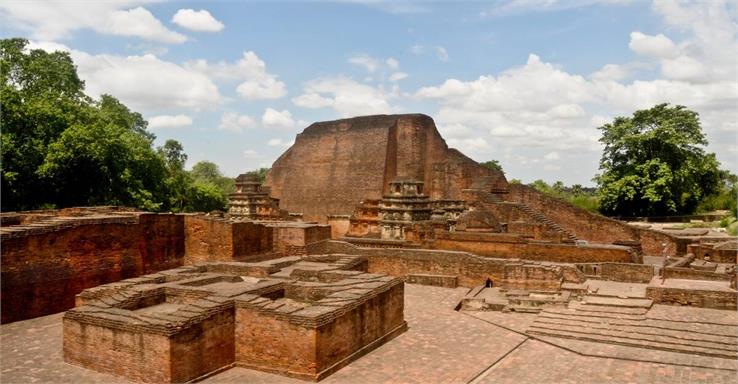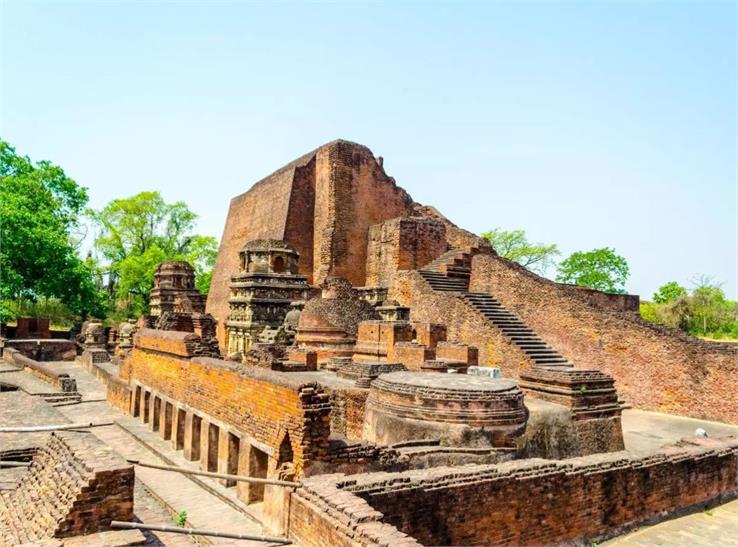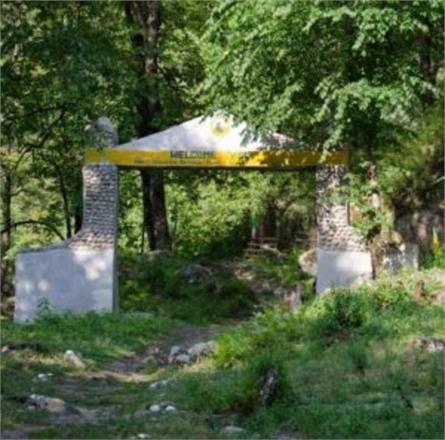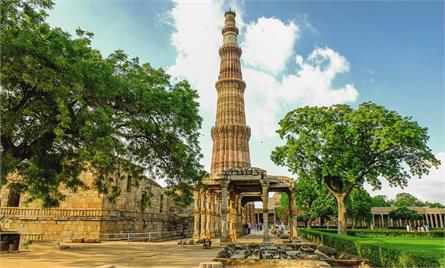Nalanda Mahavihara The Heritage Site In Bihar!

Nalanda Mahavihara, located in the Indian state of Bihar, is a testament to ancient India's intellectual and academic prowess. This renowned center of learning, which thrived for centuries, played a pivotal role in shaping the intellectual landscape of India and the entire Asian subcontinent. It is considered the most ancient university of the Indian subcontinent and was a learning center for over 800 years.
The university was established during the Gupta Empire era and was supported by numerous Indian and Javanese patrons - Buddhists and non-Buddhists. Nalanda Mahavihara taught six primary Buddhist schools and philosophies, such as Yogachara and Sarvastivada, and subjects like Vedas, grammar, medicine, logic, mathematics, astronomy, and alchemy.
The architecture of Nalanda Mahavihara was considered an architectural masterpiece spread over an area of 23 hectares. A high wall and a massive gate covered the institution of several temples, viharas (educational and residential buildings), compounds, stupas, classrooms, and meditation halls.
Also Read: UNESCO World Heritage of India
Historical Significance of Nalanda Mahavihara | Great Monastery of Nalanda
Nalanda Mahavihara was one of the world's most renowned ancient learning centers. Its history is rich and fascinating, spanning over several centuries. Here is a brief of the history of Nalanda Mahavihara:
1. Foundation (5th Century CE)
Nalanda Mahavihara was founded during the Gupta dynasty, around the 5th century CE. It is believed that it was established under the patronage of the Gupta emperors, notably Kumaragupta I.
2. Early Development (5th-7th Century CE)
Under the guidance of eminent scholars like Kumarajiva and Buddhapalita, Nalanda started to gain prominence as a center for Buddhist learning. It attracted students and scholars from all over Asia.
3. Hiuen Tsang's Visit (7th Century CE)
The Chinese Buddhist monk and traveler Hiuen Tsang (Xuanzang) visited Nalanda in the 7th century. His detailed accounts of Nalanda provide invaluable historical insights into the institution's curriculum, infrastructure, and the vast library it housed.
4. Golden Age (8th-12th Century CE)
Nalanda reached its zenith during this period, becoming a global learning hub. It had numerous monasteries, lecture halls, and a massive library known as Dharmaganja.
Scholars like Nagarjuna, Asanga, and Dharmapala significantly contributed to Buddhist philosophy and other subjects at Nalanda.
5. Legacy and Influence
Nalanda's legacy continued to thrive in other parts of Asia as its scholars spread Buddhist teachings and knowledge.
The impact of Nalanda on the development of Buddhism, as well as various other fields of knowledge, was profound and enduring.
6. Rediscovery (19th-20th Century CE)
Nalanda was forgotten mainly when its archaeological remains were rediscovered in the 19th century. This led to renewed interest in its history and significance.
7. Modern Revival (20th Century CE)
In the 1950s, the Government of India established Nava Nalanda Mahavihara near the ancient site as a modern center for Buddhist studies and research.
8. Nalanda University (21st Century CE)
In 2010, the government announced plans to revive Nalanda University as a modern learning institution. The new Nalanda University aims to carry forward the legacy of the ancient Nalanda Mahavihara and promote academic excellence.
Nalanda Mahavihara's history reflects its importance as a seat of learning that attracted scholars and students from different parts of the world, contributing to the spread of knowledge, particularly in Buddhism and philosophy. Its decline, though unfortunate, did not diminish its historical and cultural significance, and efforts to revive its legacy continue into the 21st century.
Also Read: A Historical Tapestry of Ajanta Caves
Story Behind The Decline of Nalanda’s Vast University
The story behind the burning of Nalanda University is a tragic one. It thrived from the 5th to the 12th century CE and attracted scholars and students from all over the world. Unfortunately, in 1193, the university fell victim to an invasion led by Bakhtiyar Khilji, a Turkish military commander.
Legend has it that Bakhtiyar Khilji, after defeating the local ruler, came across Nalanda University. Upon seeing the grandeur and vastness of the institution, he ordered his soldiers to set the library on fire. It is said that the library burned for several months, destroying countless valuable texts, manuscripts, and artifacts.
The burning of Nalanda University is seen as a significant loss to the world's intellectual heritage. The destruction of such a prestigious learning center was a devastating blow to the spread of knowledge and education in ancient India.
However, despite the destruction, the spirit of Nalanda continues to inspire modern-day scholars and researchers. Efforts have been made to revive the university, and Nalanda University has been re-established as an international institution recently. While the original Nalanda may be lost, its legacy lives on in the pursuit of knowledge and the promotion of education.
Academic Excellence
Nalanda's vast library contained a remarkable collection of texts on various subjects, including philosophy, mathematics, medicine, astronomy, and linguistics. Its curriculum was comprehensive, encompassing Buddhist philosophy, Hinduism, Jainism, and other subjects. The university had an illustrious faculty that included scholars like Nagarjuna, Aryadeva, and Vasubandhu.
The education system at Nalanda was holistic and interdisciplinary. Students were encouraged to engage in debates and discussions, fostering critical thinking and intellectual exploration. The institution emphasized the importance of debate and intellectual inquiry, which made it a hub for scholars and intellectuals of diverse backgrounds.
Nalanda's Legacy
The legacy of Nalanda Mahavihara extends far beyond its historical period. It served as a bridge for transmitting knowledge between India and other parts of Asia. Students and scholars from China, Tibet, Korea, and other regions flocked to Nalanda to study and return their knowledge to their respective lands. The renowned Chinese Buddhist scholar Xuanzang spent several years at Nalanda, researching and contributing to the library's expansion.
Rediscovery and Revival
The rediscovery of Nalanda Mahavihara began in the early 19th century. In 1811, Sir Francis Buchanan-Hamilton, a Scottish geographer and surveyor, visited the site and identified it as the ruins of a Buddhist university. He made a brief report of his findings, but it was not until the 1860s that more systematic excavations were carried out.
The first major excavation of Nalanda was conducted by Alexander Cunningham, an Indian archaeologist, between 1861 and 1862. Cunningham's excavations revealed the remains of several monastic complexes and a large library. He also found several inscriptions, which helped to date the site and provide information about its history.
Subsequent excavations have been conducted by several other archaeologists, including Nalini Kanta Bhattasali, K. N. Dikshit, and T. N. Ramachandran. These excavations have further added to our knowledge of Nalanda and have revealed more about its architecture, layout, and teaching methods.
The revival of Nalanda Mahavihara began in the early 21st century. In 2006, the Indian government announced plans to rebuild the university. The new university was inaugurated in 2014, and it now has over 1,000 students worldwide.
The new Nalanda University is a secular institution that offers courses in a variety of subjects, including Buddhist studies, philosophy, and mathematics. It is also committed to promoting interfaith dialogue and understanding.
The rediscovery and revival of Nalanda Mahavihara is a significant event in the history of Buddhism and higher education. It is a reminder of the importance of preserving and reviving our cultural heritage and of the power of education to transform lives.
Also Read: The Majestic Agra Fort
Here are some of the key events in the rediscovery and revival of Nalanda Mahavihara:
1811: Sir Francis Buchanan-Hamilton identifies the ruins of Nalanda Mahavihara.
1861-1862: Alexander Cunningham conducts the first major excavation of Nalanda.
1915-1937: Nalini Kanta Bhattasali conducts further excavations at Nalanda.
1954-1974: K. N. Dikshit conducts further excavations at Nalanda.
2006: Indian government announces plans to rebuild Nalanda Mahavihara.
2014: New Nalanda University is inaugurated.
The rediscovery and revival of Nalanda Mahavihara is a work in progress. The new university is still in its early stages, and it remains to be seen how successful it will be in achieving its goals. However, the mere fact that the university has been revived is a significant achievement, and it is a testament to the power of education and the importance of preserving our cultural heritage.
Today, the Nalanda Archaeological Site is a UNESCO World Heritage Site, attracting worldwide tourists, scholars, and history enthusiasts.
Nalanda Mahavihara symbolizes India's rich intellectual heritage and profound education and knowledge contributions. Despite its tragic decline, its legacy endures through the countless scholars and students who benefited from its teachings and the timeless wisdom contained within its ancient library. Nalanda serves as a reminder that knowledge, once gained, is a force that transcends time and place, and its pursuit remains an eternal quest for humanity.














